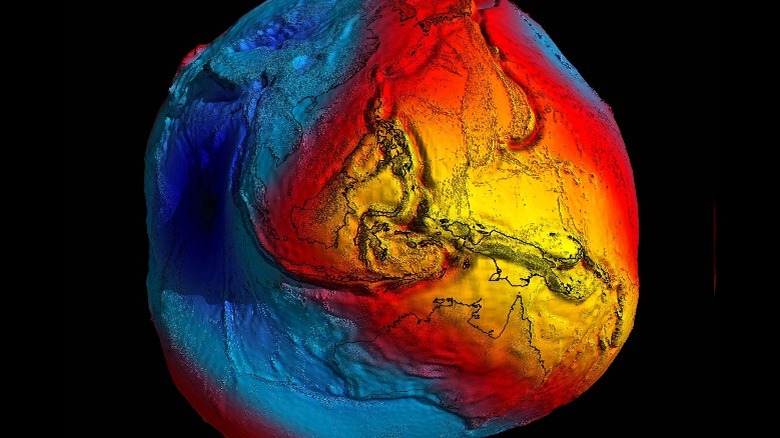The Gravitational Anomaly That Might Have You Weighing Less In Canada
Gravity isn't uniform all over the Earth. It turns out Canada has a little bit less of it than most of the rest of the world. According to Condé Nast Traveler, the average Hudson Bay resident clocks in roughly one-tenth of a pound lighter than their neighbors. But why? The Canadian region seems to be "missing" gravity.
For the longest time, scientists weren't quite sure why Canada was "missing" gravity. It's been described as an anomaly. In this age of technology, however, we did what we often do when we can't figure out what's going on with Earth: We go to outer space and turn things over to the expertise of satellite technology (via New Scientist).
In 2007, scientists believed they've found the truth about why everyone in the Hudson Bay region weighs just a little bit less than they would otherwise. The case of the gravity anomaly was at last addressed. Here's what we know.
What does ancient ice have to do with it?
So how is it possible you could weigh less in one region of the Earth? If you're thinking that this doesn't quite fit in with the canon of scientific law we're taught, you're absolutely right. It's perplexed scientists, too. But as scientists tend to do, they've come up with theories. The first involves some ancient ice.
Long, long ago (we're talking over 10,000 years ago), there was a massive crust of ice covering most of modern-day Canada and the United States, as Jacob Silverman of How Stuff Works eloquently explains. This ice sheet, he says, was a bit heavier in the Hudson Bay region — about 0.3 inches heavier — than the rest of the vicinity. According to Silverman (and proponents of this theory), when the Laurentide Ice Sheet melted away 10,000 years ago, this ice — which was so heavy it left an indentation in the Earth's crust — left a greater indentation in the Hudson Bay area, pushing away the Earth's crust and thereby giving that region less terrestrial mass. Less mass? Less gravity. Clear as ice?
The second theory is less complicated: magma, weighing down the Earth's crust, is less concentrated in the Hudson Bay area due to a process known as convection. Once again, less mass equals less gravity. But aren't these just theories?
The Hudson Bay region is still 'indented' from that ancient ice
While gravity distribution varies slightly across the globe (via New Scientist), the Canadian Gravity Anomaly is unusually extreme, at one-tenth of a pound absent from one's weight. The phenomenon exists in other portions of the globe, too. Because the Earth is not a perfect circle, its mass varies slightly (as in very, very slightly) from place to place. What's going on in Canada, however, is still pretty weird.
The Canadian Gravity Anomaly is so weird, in fact, that it caught the interest of scientists at NASA. The GRACE Mission (Gravity Recovery and Climate Experiment), launched in 2002 in cooperation with the German Aerospace Center (per NASA/Earth Data), studied the site of the anomaly (as well as gravity more generally) with remarkable detail from space. The GRACE I and GRACE II satellites produced monthly maps of variations in the Earth's gravity from point-to-point, based on water fluctuations and the Earth's shifting crust, and it could measure distances up to as narrow as the width of a human hair. This allowed them to investigate the Hudson Bay's mysterious gravity deficit. After 15 years in orbit, the GRACE satellites ran out of batteries in 2017 — but not before they investigated the Hudson Bay anomaly (via NASA/Jet Propulsion LAB at CIT).
The Canadian Gravity Anomaly solved?
The mission found that the region does in fact have less mass (and the ancient ice theory seems to be the favorite of scientists). The GRACE Mission explains it well on its delightfully 2000s-era website: "Gravity anomalies are often due to unusual concentrations of mass in a region ... [T]he presence of ocean trenches or even the depression of the landmass that was caused by the presence of glaciers millennia ago can cause negative gravity anomalies." Yes, they're subtweeting Canada right there.
In summary? The one-tenth of a pound you lose when entering the Hudson Bay region of Canada isn't actually yours to lose; there's just less mass in that region (which means less gravity) thanks to the weirdness of the world tens of thousands of years ago when the site of your modern-day Tim Hortons rested beneath 2.3 miles of ice. However, if you'd like to start a conspiracy theory about paranormal vortexes or windows to parallel words in the Hudson Bay area, nobody on Earth can stop you.



